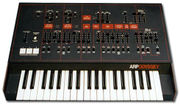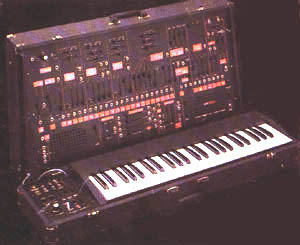 ARP ODYSSEY
ARP ODYSSEY |
Weapon
of Choice:
ARP |
 ARP 2600
ARP 2600 |
The
ARP synthesizer company was founded by Alan R. Pearlman in 1970.
The company produced some the most influential keyboard instruments
of the 70's until closing its doors in 1981.
The
ARP Odyssey was an analog synthesizer introduced
in 1972. Responding to pressure from Moog Music to create a portable,
affordable (the Minimoog was US$1,495 upon release) "performance"
synthesizer, ARP scaled down its popular 2600 synthesizer and created
the Odyssey, which became the best-selling synthesizer they made.
The Odyssey is a two-oscillator analog synth (the Minimoog has 3
oscillators and its sound is considered "fatter"). The
Odyssey was the first synthesizer with duophonic capabilities (the
ability to play two notes at the same time). Many cite ARP's semi-modular
2600 as the first duophonic synthesizer; however, the 2600 was originally
shipped with a monophonic controller keyboard, with a duophonic
keyboard not being released until after the Odyssey's release. One
potential appeal of the Odyssey is the fact that all parameters,
including a resonant low-pass filter, a non-resonant high-pass filter,
ADSR and AR envelopes, triangle (not sine) and square wave LFO and
a sample-and-hold function, are editable with sliders and buttons
on the front panel.
The ARP 2600 is a semi-modular analog subtractive
audio synthesizer, designed by Alan R. Pearlman and manufactured
by his company, ARP Instruments, Inc. Unlike other modular systems
of the time, which required modules to be purchased individually
and wired by the user, the 2600 was semi-modular with a fixed selection
of basic synthesizer components internally pre-wired. The 2600 was
thus ideal for musicians new to synthesis due to its ability to
be operated either with or without patch cords, and was, upon its
initial release, heavily marketed to high schools, universities,
and other educational facilities.
Three versions of the ARP 2600 were built during ARP's lifetime.
The first, dubbed the "Blue Meanie,"
housed in a light blue/gray metal case, was assembled in a garage
during ARP's infancy as a company. Later ARP 2600's were built in
a vinyl case and contained an imitation of Bob Moog's infamous 4-pole
"ladder" VCF, later the subject of an infamous, threatened
(though ultimately nonexistent) lawsuit. Finally, in order to fit
in with the black/orange theme of ARP's other synthesizers, the
ARP 2600's were manufactured with orange labels over a black plastic
panel.
Alan R. Pearlman was just as innovative as a salesman as a synthesizer
designer, as he gave away synthesizers to famous musicians, namely
Edgar Winter, Pete Townshend,
Stevie Wonder, and Herbie Hancock,
to supply ARP with free publicity. Other famous users were Chick
Corea, Devo, Tom Coster, Stevie
Wonder, George Duke, and Kraftwerk.
The enduring popularity of the ARP 2600 has led to software companies
such as Arturia and Way Out Ware
releasing software emulations for use with modern music equipment
such as MIDI devices and computer sequencers. Although technology
has progressed to the point where the ARP 2600 can be emulated fairly
accurately, the idiosyncrasies of analogue circuitry make an exact
replica arguably impossible.
-- courtesy of wikipedia
|
